1. Installation
 -
Page 1
-
Page 1
- Introduction:
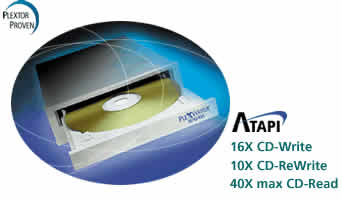 The
previous year (2000) has been a great one for Plextor. They managed to introduce
high quality products (like the PX-W1210A/S), but in November 2000 they lost
the title of the maker of the fastest recorder in the planet. Yamaha made the
big surprise when they introduced the 2100x series, which supported 16x writing
(even partial) and up to 40x reading speed. Other manufacturers (such as TDK)
shipped *real* 16x writers two months later (January 2001). Plextor fans started
worrying since Plextor didn't seem to react to the increased competition and
seemed to stay back in the writing race. Finally Plextor announced in January
2001 that they would ship PX-W1610A in Feb 2001. Many users waited to upgrade
their recorder after the shipping of Plextor PX-W1610A, but many others did
not and chose either Yamaha 2100x or TDK CyClone 161040. Who has done the right
selection and who didn't? Let's find out!
The
previous year (2000) has been a great one for Plextor. They managed to introduce
high quality products (like the PX-W1210A/S), but in November 2000 they lost
the title of the maker of the fastest recorder in the planet. Yamaha made the
big surprise when they introduced the 2100x series, which supported 16x writing
(even partial) and up to 40x reading speed. Other manufacturers (such as TDK)
shipped *real* 16x writers two months later (January 2001). Plextor fans started
worrying since Plextor didn't seem to react to the increased competition and
seemed to stay back in the writing race. Finally Plextor announced in January
2001 that they would ship PX-W1610A in Feb 2001. Many users waited to upgrade
their recorder after the shipping of Plextor PX-W1610A, but many others did
not and chose either Yamaha 2100x or TDK CyClone 161040. Who has done the right
selection and who didn't? Let's find out!
- Package:
 The
retail version that arrived at our offices included:
The
retail version that arrived at our offices included:
1) The drive (PX-W1610A)
2) The electronic pdf manual
3) The RMA request form, registration card
4) A quick installation guide
5) 2 blank CDs (one recordable and one HS RW erasable)
6) An IDE cable, an audio cable and screws
7) WinOnCD Version v3.8.650-D as the main recording software, Adaptec DirectCD
v5.0 for packet writing use (supports both Win9x and Win2k OS) and finally the
known "PlexTools" v1.08. The retail package for the USA users will
be somewhat different, since it includes Ez CD Creator 4.x and Plextor Manager
2000 as the recording software.
There is a change from the past especially in the manual, which is now not
printed but supplied as a pdf document. However, we couldn't help noticing that
the European Plextor manual is still poor compared to what Yamaha and TDK ship
with their drives. You can also try to download the USA
version PX-W1610A manual that seems better than the supplied one! The included
CDR media was branded Plextor, but the real manufacturer is Ricoh. Last, the
HS-RW media comes from Mitsubishi (as introduced in the PX-W1210S
series).
The front of the PleXWriter PX-W1610A is the same as introduced
in the PX-W1210A. The drive contains the "16/10/40", "BPRec"
and the "High Speed" logos and with a quick look gives users an idea
about the drive capabilities. The PleXWriter PX-W1610A also contains a new technology
called "Powerec" - Plextor Optimized writing Error Reduction
Control: "...Plexwriter 16/10/40 in addition to the OPC, distinguishes
the manufacturer name & the type name & the characteristic of the media
automatically, it records at laser power and the speed which are optimum to
that disk. That ensures that the speed which will be written is the highest
possible and error-free.."

In the back of the drive, you will notice something interesting:
The addition of an "extra fan" that both the Yamaha 2100x and the
TDK CyClone 161040 don't support. This feature is needed to keep the drive cool
when it used at high temperature environment or writing up to 16x. The Sanyo/TDK
drives have many holes to keep the temperature down, which the PX-W1610A doesn't.
Also, notice the two left pins, which are not used - only for factory use. You
will understand why later!

- Installation:
 Installing
IDE CDR-W drives is very simple. Just select if the drive will be master or
slave and fire up the power! We simply installed the drive as master in the
Secondary IDE bus. During boot-up, the BIOS identified the drive as Plextor
CD-R PX-W1610A and after disabling "Auto-insert notification" we rebooted.
The supplied drive was manufactured in January 2001 (TLA #0000) and the onboard
firmware revision was version 1.00.
Installing
IDE CDR-W drives is very simple. Just select if the drive will be master or
slave and fire up the power! We simply installed the drive as master in the
Secondary IDE bus. During boot-up, the BIOS identified the drive as Plextor
CD-R PX-W1610A and after disabling "Auto-insert notification" we rebooted.
The supplied drive was manufactured in January 2001 (TLA #0000) and the onboard
firmware revision was version 1.00.
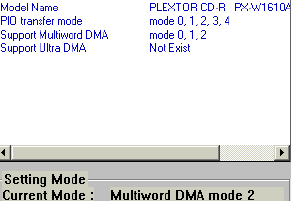 We
used for our tests mostly Nero 5.0.3.9 and Ahead InCD v1.79. Novice users will
find the bulked WinOnCD/DirectCD and PlexTools easy to use so it is recommended
to install them. The drive worked in "PIO Mode 4" as the VIA IDE tool
reported (check right picture). Many users had reported that if you jumper
the two left pins of the previous PX-W1210A model the drive would work at UDMA
2 (ATA33) mode! Since the new drive also included those two pins we also tried
and guess what: It worked!
We
used for our tests mostly Nero 5.0.3.9 and Ahead InCD v1.79. Novice users will
find the bulked WinOnCD/DirectCD and PlexTools easy to use so it is recommended
to install them. The drive worked in "PIO Mode 4" as the VIA IDE tool
reported (check right picture). Many users had reported that if you jumper
the two left pins of the previous PX-W1210A model the drive would work at UDMA
2 (ATA33) mode! Since the new drive also included those two pins we also tried
and guess what: It worked!
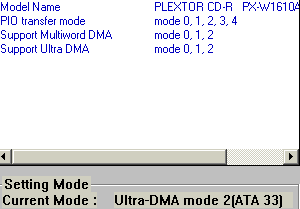 After
we jumper those 2 left pins the PX-W1610A also worked in Ultra-DMA mode. What
this mean for you? Our tests shown: 1) Low increase of the reading performance
(not noticeable) and 2) High decrease in the CPU usage - up to 36%! Keep in
mind that this mode is not supported officially from Plextor (not so
sure about this after all-read below) so if you decide to use it would be at
your own risk. Our tests however didn't show any weird behaviour after the "jumper-hack"
:)
After
we jumper those 2 left pins the PX-W1610A also worked in Ultra-DMA mode. What
this mean for you? Our tests shown: 1) Low increase of the reading performance
(not noticeable) and 2) High decrease in the CPU usage - up to 36%! Keep in
mind that this mode is not supported officially from Plextor (not so
sure about this after all-read below) so if you decide to use it would be at
your own risk. Our tests however didn't show any weird behaviour after the "jumper-hack"
:)
Continuing our UDMA 2 quest we discovered that:
1) The Plextor
USA site reports that the drive can work at both PIO Mode4 and DMA2 and
suggests that you enable the DMA from the BIOS "..ATAPI interface: DMA
should be set to ON in operating system. IDE controller must be set to PIO Mode
4 or DMA Mode 2..." However misses to report how enable UDMA 2 for the
drive in the first place :)
2) On the other hand the Plextor
Europe site reports only "...ATAPI Interface (PIO Mode-4)..."
in the specification page. Confused? We are, too!
Test Machine:
WinMe OS
Soyo 7VCA
Celeron II 566 over clocked to 850 MHz
128MB SDRAM PC 133
WD 18GB UDMA 66
Quantum Fireball EX 6.4GB
SCSI card: DAWI 2975 - PCI (ULTRA)
ATI AIW 128
PleXWriter PX-W1610A firmware v1.00 (TLA #0000)
Sanyo CRD-BP1400P firmware v5.29
Yamaha CRW2100E firmware v1.0h
TDK CyClone 161040 firmware v5.29
2. Data Tests
 -
Page 2
-
Page 2
Data Tests
Test Method:
- SCSI Mechanic v3.0.0.224: This was used to compare the Plextor's
I/O performance against other various CDR-W drives (see charts). We used
a pressed CD containing PlexTools v1.06 for all of the tests.
- CD Speed 99 v0.80 was also used to check the drive performance
with pressed CDs. For that test we used PlexTools v1.06 original CD.
- SCSI Mechanic v3.0 results:

As you can see from the graph above, the PX-W1610A is the
fastest CDR-W drive currently available. The drive's performance was the
best in all 3 tests: Best "Average Random I/O" (776kb/s), "Average
Sequential I/O" (4612kb/s) and "Average Same Sector I/O"
(13780) results. The competition simply follows, in the forms of TDK CyClone
161040/Sanyo CRD-BP1400P (second/third) and the Yamaha 2100E (fourth). Very
good performance from the PX-W1610A! (Remember all 4 drives support up to
40x reading).
- CD Speed 99 v0.80 results (check the CD Speed graph over
here)

Using CD Speed 0.80, we can see that the PX-W1610A again
has the fastest "average speed" (30.92x). The TDK CyClone/Sanyo
CRD-BP1400P follows (29.92x) and Yamaha again comes last (28.83x).

In the seek times tests, the PX-W1610A gave out the highest times which made
it come last. The TDK CyClone/Sanyo CRD-BP1400P drives give the lowest seek
times, Yamaha follows and the PleXWriter comes fourth. The time difference is
not that big but there is.
3. RW reading tests
 -
Page 3
-
Page 3
RW reading
tests
For the RW tests, we used Ricoh HS RW media written at 10x
speed (except for Yamaha 2100E, which supports only 8x writing). The Yamaha
2100E is the fastest in this test since the drive is capable of reaching
up to 40x (with RW media). The TDK CyClone/Sanyo drives come second/third
and the PleXWriter PX-W1610A last:

CloneCD Tests
Procedure:
We used the latest CloneCD (v2.8.4.3) and 3 original CDs (Rally Masters,
Euro2000 and V-Rally 2) in order to test the RAW reading time for the PleXWriter
PX-W1610A (firmware v1.00). We also tested the reading performance with
backups of the original CDs since the reading speed varies among original
and backup media. For comparison reasons we added the results from the Yamaha
2100x, TDK CyClone 161040/Sanyo CRD-BP1400P. The drive is fully supported
in CloneCD:

Results:
a) SafeDisc Results:Euro 2000 (Total: 257982 sectors - 10141 bad
sectors) - Reading Speed: Max

The PleXWriter PX-W1610A is the fastest CDR-W drive you can find
when reading SafeDisc 1/2 protected CDs. The Yamaha 2100E comes second and the
TDK CyClone/Sanyo last.
b) LaserLock Results: Rally Masters (Total: 321528
sectors - 6317 bad sectors) - Reading Speed: Max
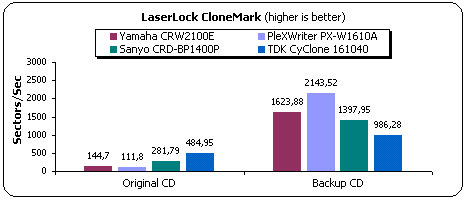
The PleXWriter PX-W1610A had a hard time reading LaserLock protected
CDs. The drive took nearly 45mins to make the image of the protected CD. This
however doesn't apply for the backup CD...
c) SecuROM Results: Vrally2 Expert - 343767 sectors
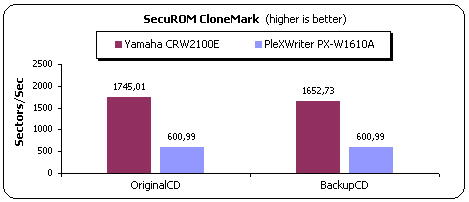
The PlexWriter PX-W1610A can read both SubChannel
data from audio/data tracks but hell slow... The drive took the same time for
the original/backup CD (around 9.5mins) when the Yamaha 2100E drive needed only
3.5mins to end the task.. Note that the so called "jumper hack" didn't
affected the SubChannel reading capability of the drive.
4. DAE Tests
 -
Page 4
-
Page 4
DAE Tests
- Test Method:
We used CD DAE 99 v0.2 and EAC v0.9 prebeta 8 software
in order to check DAE performance of the Plextor PX-W1610A with various
AudioCDs. We have added EAC back to the testing arena since many users requested
it. Note that the posted DAE results are the average of both applications,
but the CPU usage is only taken from CD DAE 99. EAC seems to occupy the
system much more. As a last note, we used the "BURST" reading
mode of EAC. Use made a full CD Rip starting from the first to the last
track of the CD. The Average DAE reported speed along with the CPU Usage
is displayed in the test graphs.
 -
DAE features:
-
DAE features:
We used EAC v0.9 prebeta 8 to examine the drive's features. As the program
reported, the drive "Caches" data, and supports "Accurate
Stream" and "C2" error info. However our attempts to activate
"C2" error info always locked our PC :( The specifications state
that the drive can reach up to 40x DAE (max)!
- Pressed AudioCD results (check the CD
Speed graph over here):
We can announce the new king of DAE performance! The PX-W1610A is simply
the fastest CDR-W drive in the DAE ripping speed! The drive can go up to
40x and the average ripping speed is around 30x. The Yamaha 2100E
that also supports 40x DAE (max) lags behind with 28x and the TDK/Sanyo
drives come last (23x). The CPU usage is also increased and the UDMA
2 mode (jumper hack) didn't seem to help here:

- CDR AudioCD Tests:
The PX-W1610A working great with CDR media and has not problem to climb
to 31.5x! The Yamaha 2100E still comes second (28.1x) and the TDK/Sanyo
drives last (23.5x):

- Advanced DAE Quality:
The PX-W1610A got a perfect score (100) in the CD Speed 99 Advanced DAE
test. The competition also does perfect DAE. Notice that is this test, CD Speed
reported only 27.26x as the average speed, which is slower than what Yamaha
2100E got in the same test! We used many CDs and we got the same results so
it's must be a program error we thought in the start. The CD Speed author said
that "..During the test some lengthy calculations are done so the speed
shown in the Advanced DAE Quality Test is a bit lower than the maximum speed..."
which could explain it:

The drive supports reading from "lead-in"/"lead-out" and
can read Subchannel data as the Advanced DAE test showed. However it also reported
that the drive cannot read CD-Text which is false since the drive support CD-Text
reading (just check the specification) and worked fine with the Plextor CD-Text
player!

- Ripping 90 and 95mins AudioCDs
Ok you have written up to 95min CDs. Can the PleXWriter PX-W1610A read them?
The answer is yes and no(!) Note that the current CD DAE 99 v0.2 version
stops reading at 85mins and for that propose a new version would be released
out from CD DAE 99 author (Erik Deppe)
soon.
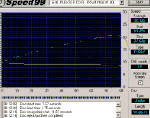 We
used Nero 5.0.3.9 and made a 91min task -overburned 90min CD - (supplied
from Medea International).
After we used CD Speed 99 to quick measure the drive's performance. The
drive performed very good and it gave back average 34x ripping speed! There
is however a slow down after 80mins (check left picture).
We
used Nero 5.0.3.9 and made a 91min task -overburned 90min CD - (supplied
from Medea International).
After we used CD Speed 99 to quick measure the drive's performance. The
drive performed very good and it gave back average 34x ripping speed! There
is however a slow down after 80mins (check left picture).
 After
that we used the 95min AudioCD which has been created using Nero 5.0.3.9 and
99min CD (supplied from Disc
4 You). The drive reads the first track OK, but then seems to have problems
from 10-40min. After that, it continues at normal speed until it reaches 90mins.
Then again, it slows down to 4x. Also, notice that the drive produces lot of
reading errors and the DAE seems very bad (got 0 score). The problem is not
with the drive but with the media... Remember that both 90 and 99-minute CDs
are not officially supported by any CD standard!
After
that we used the 95min AudioCD which has been created using Nero 5.0.3.9 and
99min CD (supplied from Disc
4 You). The drive reads the first track OK, but then seems to have problems
from 10-40min. After that, it continues at normal speed until it reaches 90mins.
Then again, it slows down to 4x. Also, notice that the drive produces lot of
reading errors and the DAE seems very bad (got 0 score). The problem is not
with the drive but with the media... Remember that both 90 and 99-minute CDs
are not officially supported by any CD standard!
5. CDR Tests
 -
Page 5
-
Page 5
CDR Tests
The PleXWriter PX-W1610A supports 16x CLV writing. The TDK/Sanyo drives were
the first ever to support 16x CLV writing, and Yamaha 2100x series was the first
company ever presented 16x writer, which however used partial 16x writing (CAV).
The main difference between the 2 technologies is that 16x CLV should be faster
around 15sec (in a full 74min CD). Using CD Speed 99 software, we were able
to confirm the writing speed results:

- Procedure:
We tested the PleXWriter PX-W1610A with Nero v5.0.3.9, CloneCD v2.8.4.3
software and with the following media: Princo 74min (16x) & 80min (16x),
Platinum 80min (12x), Verbatim 74min (16x) & 80min (16x), Mitsui 74min
(16x), Ricoh/Plextor/Verbatim 74min HS RW.From our tests, the drive wrote
just fine 12x certified media but it is suggested that you use 16x certified
media since they are easy to find anyway. Note that the reported CPU usage
was measured when using the default "PIO Mode4". If you decide
to do the "jumper-hack" and force the drive to work in "UDMA
2" mode the CPU usage will drop down by around 36% percentage and,
for example, with 16x writing speed, you will get only 7%!
- Recomended media/support:
Both
Plextor Europe and USA
sites have lists with reccomended media. In order to get the best possible
performance you are advised to check the lists. If you are facing any problem
with the drive, Plextor USA has a list
with all the possible problems and available solutions.
- CD-R Tests:
We created "DataCD" job with data slight higher than 74mins
(74:03:65). We burned the same job with all 4 CDR-W drives:

As we can see all 4 tested, drives gave the same exact burning
time (404sec). The PX-W1610A needed one more sec to finish the task, which
of course is negligible. The CPU Usage is in the same levels as the competition
(9%), but when working in the "UDMA 2" mode, it drops down to
5%!

Now let's see the 16x writing speed performance. The PleXWriter
PX-W1610A gave back the lower recording time from what the competition is
able to do. The drive took only 5:10mins to finish the task, the Sanyo/TDK
drives need 2-4 secs more and the Yamaha 2100E stays back with 14 whole
secs (as you should expect it since the drives have different 16x writing
technology). The CPU Usage is very good (11%) and can drop down to 7% if
you decide to do the "jumper-hack".
- 80min CDs:
As previous we created a DataCD (80:02:16) and used the same media for
all burns:

The Sanyo/TDK drives did very well in this test and gave
back the lower recording time. The PX-W1610A needs one more second to finish
the 80min task and Yamaha 4secs more.

At the 16x recording speed, again the PX-W1610A/Sanyo and TDK drives deliver
the lowest recording time (334sec). The Yamaha 2100E lags behind, as it is 19sec
slower. The time difference between 16x CLV and 16x CAV writing speeds has increased
in this test.
- Overburning Tests:
We used 90 and 99min CDs (from Medea
International and Disc
4 You) and using Nero we were able to write up to 95minutes. The Plextor
PX-W1610A has increased overburn capability over the previous Plextor models:
|
90min CD
|
99min CD
|
|
Plextor 161040
|
92:06:43
|
94:59:00
|
|
Yamaha 2100E
|
89:02:34
|
89:02:34
|
|
Sanyo BP1400P
|
92:08:21
|
93:46:32
|
|
TDK 161040
|
92:08:55
|
93:45:02
|

- AudioCD Tests:
We created several Audio CDs (including CD-Text). All of the CDs we
created were tested with the Plextor PX-40TS and Plextor's CD-Text compatible
CD player. From what we saw, everything worked just fine.
- CloneCD Tests:
 The PleXWriter PX-W1610A supports DAO-RAW according to CloneCD v2.8.4.2.
This was confirmed from our test results. The drive as you have noticed
doesn't support simulation, which the competition (Yamaha 2100E) does. That's
not a big problem, since the CDR media is very cheap nowadays. As with other
16x writing drives, CloneCD doesn't display the 16x write speed option but
if you set the write speed at "MAX" it will do the job fine. Last
according to our tests the drive is not capable of making working backups
of SafeDisc 2 protected CDs. This means that the drive can backup the CD
BUT it will not work in other CD-ROMs/CDR-W drive except itself. The competition
also fails to produce working backups (Yamaha 2100E) of SD2 protected CDs.
The PleXWriter PX-W1610A supports DAO-RAW according to CloneCD v2.8.4.2.
This was confirmed from our test results. The drive as you have noticed
doesn't support simulation, which the competition (Yamaha 2100E) does. That's
not a big problem, since the CDR media is very cheap nowadays. As with other
16x writing drives, CloneCD doesn't display the 16x write speed option but
if you set the write speed at "MAX" it will do the job fine. Last
according to our tests the drive is not capable of making working backups
of SafeDisc 2 protected CDs. This means that the drive can backup the CD
BUT it will not work in other CD-ROMs/CDR-W drive except itself. The competition
also fails to produce working backups (Yamaha 2100E) of SD2 protected CDs.
- Buffer Underrun Tests:
The PleXWriter PX-W1610A includes the improved BURN-Proof technology
(with a gap length of 2micro meters), which eliminates buffer under-runs
and of course "coasters". The verification from the BURN-Proof
Center makes sure that the drive will work fine, even under heavy pressure
from the user. Our simple tests confirmed that BURN-Proof is working perfectly
with the PX-W1610A.
- Verdict of CDR Results:
The PleXWriter PX-W1610A worked very good in all our tests. The increased
16x writing speed will keep the user satisfied since the drive seems not
to have any problems with all inserted media. The drive gave back the lower
recording time from the competition and this really can make it the fastest
recorder around. Overburning is working great, and you will be able to write
up to 95min CDs!
The BURN-Proof technology is there and will save you from any Buffer Underrun.
Lastly, CloneCD users will on the one hand be happy since the DAO-RAW feature
is working fine, but on the other hand also disappointed since the drive can't
make working backups of SD2 protected CDs (however, the competition can't either).
6. RW Writing Tests
 -
Page 6
-
Page 6
RW Writing
Tests
We used Nero 5.0.3.9 for writing CDs in 10x RW writing speed
since the drive supports the new HS RW recording standard. We created a
74min Data Job task and burned it with all four recorders:

The PX-W1610A simply gave back the lower recording time in
this test with 488secs. The Sanyo/TDK Drives needs 2-3 more secs to end
the task the of course Yamaha 2100E cannot compete here since it supports
only 8x re-write speed. The erase time was higher than the competition does
(60sec). No problems were noticed when writing to 10x with new adopted Mitsubishi
HS RW media.
- Packet Writing Tests:
We used Ahead InCD v1.79 for all Packet Writing tests. We used the Plextor
74min HS-RW media and we formatted it. The formatting of the media takes
around 8min. After formatting, we tested all three drives for their packet
writing performance. The formatted disc had 530mbs of free space. We copied
a 403 MB file (403.1476kbs) from a Hard Disk (on the same pc as the writers)
to the formatted RW media-using explorer (we dragged and dropped). We performed
the test twice, to eliminate possible time measurement faults and user errors:
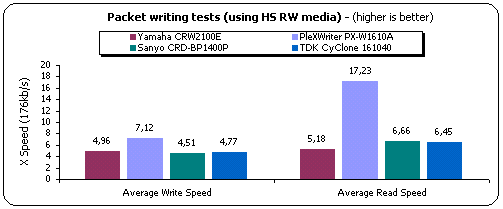
The results show clearly that the Plextor PX-W1610A drive has
the best reading/writing speed results when compared to the other three drives.
Here is another big improvement over the previous Plextor models, especially
in the reading area! The competition simple cannot follow and stays behind with
very low recording/reading speeds.
7. Conclusion
 -
Page 7
-
Page 7
Conclusion
|
Positive (+)
|
Negative (-)
|
|
- Real 16x (CLV) writer
- Improved Burn Proof (anti-coaster) technology
- Supports UDMA 2 mode
- Supports HighSpeed RW standard
- Supports reading/writing MMC DAO RAW
- Supports CD-Text
- Supports Overburning (write up to 95mins)
- Best Data/DAE reading performance around
- Good package
- Cooling fan!
- Good CloneCD reading performance
- Quietest drive ever tested!
|
- Failed to backup SD2 protected CDs
- Low CloneCD performance with LaserLock protected CDs
|
The PleXWriter PX-W1610A is possibly the best 16x writer
you can buy nowadays. The competition from Yamaha/TDK/Sanyo is still there
but all other 16x solutions have several problems (either in design or in
performance), which lead us in the above claim. The current price of the
drive according to the
Pricewatch is from 248$-280$. Let see what the competition has to offer:
- Yamaha 2100E: This was the first 16x recorder (not even "real"
16x) which has dominated the market since November 2000. The drive's general
reading/writing performance is very good but the drive has neither support of
10x re-writing, nor any anti-coaster technology. Its price however seems to
be lower (from 195$-250$) than the announced price of the PX-W1610A (US$250)
and already the SCSI model seems to be out (2100S).
- TDK / Sanyo 161040: This was the first real 16x recorder, which
however has several problems, especially with DAO-RAW reading/writing. If these
problems are corrected soon, the drive could become an alternative to the PX-W1610A.
Again, the drive's price seems again lower (195$-230$ for Sanyo BP1400P and
260-290$ for the TDK VeloCD 161040) than the announced price of the Plextor
drive.
If we wanted to make an summary of this review in one word
that would be "Power" - for the users. The PX-W1610A gives the
users the freedom to do almost anything they want with their recorder. From
writing CDs at 16x, to backing-up their favourite protected CD or ripping
Audio CDs at 40x (max) speed without any fear of Buffer Underruns! You
must also hear how quiet this rocket works!!! The drive seems to be
unbeatable by the competition, and the only thing that holds us back from
awarding it the title of the "Best 16x CDR-W drive," is our yesterday
post about Teac CDW-516EB, which should start selling very soon!
Do you think that Teac could make the pleasant surprise and lead
the 16x-writing race? Stay tuned!